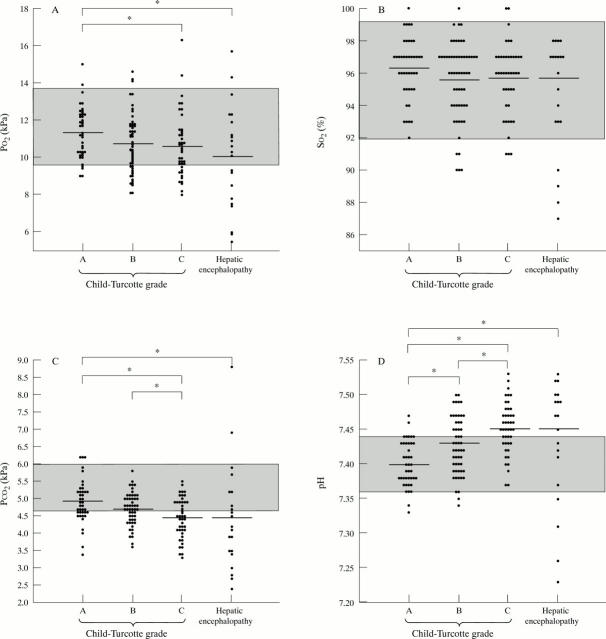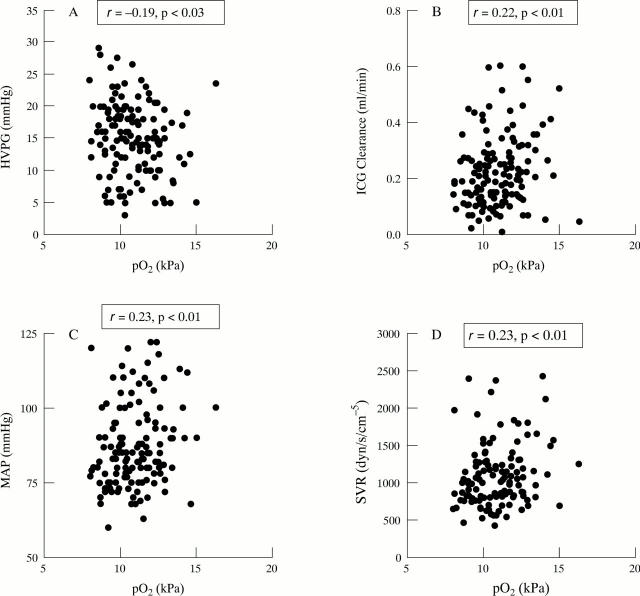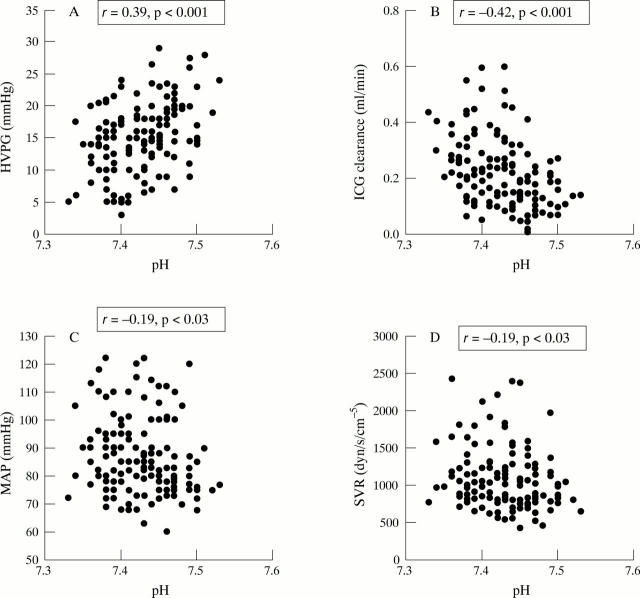Abstract
Background—Although low arterial oxygen tension (PO2) has been claimed to occur in one to two thirds of patients with cirrhosis, hypoxaemia appears to be rare in clinical practice. Aims—To assess the frequency of arterial hypoxaemia in cirrhosis in relation to clinical and haemodynamic characteristics. Patients—One hundred and forty two patients with cirrhosis without significant hepatic encephalopathy (grades 0-I) (41 patients in Child class A, 57 in class B, and 44 in class C) and 21 patients with hepatic encephalopathy. Results—Mean PO2 in kPa was 11.3 in Child class A, 10.8 in class B, 10.6 in class C, and 10.6 in patients with encephalopathy (p<0.05). The fraction of patients with PO2 below the lower normal limit of 9.6 kPa was 10%, 28%, 25%, and 43%, respectively in class A, B, C, and in patients with encephalopathy (p<0.05). Oxygen saturation (SO2) in these groups was respectively: 96%, 96%, 96%, and 93% (NS). SO2 was below the lower limit of 92% in 0%, 9%, 7%, and 24% (p<0.05). In patients without hepatic encephalopathy, a multivariate regression analysis revealed that independent determinants of a low PO2 were a high arterial carbon dioxide tension, a low systemic vascular resistance, and a low indocyanine green clearance (p<0.0001). Conclusion—The prevalence of arterial hypoxaemia in cirrhosis is about 22% in patients without encephalopathy, but it varies from 10-40% depending on the degree of hepatic dysfunction. Arterial hypoxaemia in patients with cirrhosis of differing severity seems lower than previously reported, and patients with severe arterial hypoxaemia are rare.
Keywords: cirrhosis; encephalopathy; haemodynamics; hepatopulmonary syndrome; hyperdynamic circulation; hypoxaemia
Full Text
The Full Text of this article is available as a PDF (215.9 KB).
Figure 1 .
Distribution of PO2 (A), SO2 (B), PCO2 (C), and pH (D) in 163 patients with cirrhosis stratified according to the modified Child-Turcotte criteria (A, B, or C) without hepatic encephalopathy (n=142) or with encephalopathy (n=21). Bars indicate medians and the hatched area the reference interval.
Figure 2 .
Correlation between PO2 and HVPG, ICG clearance, MAP, and SVR in 142 patients without encephalopathy.
Figure 3 .
Correlation between pH and HVPG, ICG clearance, MAP, and SVR in 142 patients without encephalopathy.
Selected References
These references are in PubMed. This may not be the complete list of references from this article.
- Agusti A. G., Roca J., Rodriguez-Roisin R. Mechanisms of gas exchange impairment in patients with liver cirrhosis. Clin Chest Med. 1996 Mar;17(1):49–66. doi: 10.1016/s0272-5231(05)70298-7. [DOI] [PubMed] [Google Scholar]
- Agustí A. G., Roca J., Bosch J., Rodriguez-Roisin R. The lung in patients with cirrhosis. J Hepatol. 1990 Mar;10(2):251–257. doi: 10.1016/0168-8278(90)90061-u. [DOI] [PubMed] [Google Scholar]
- Andrivet P., Cadranel J., Housset B., Herigault R., Harf A., Adnot S. Mechanisms of impaired arterial oxygenation in patients with liver cirrhosis and severe respiratory insufficiency. Effects of indomethacin. Chest. 1993 Feb;103(2):500–507. doi: 10.1378/chest.103.2.500. [DOI] [PubMed] [Google Scholar]
- Bendtsen F., Henriksen J. H., Becker U., Sørensen T. I. Effect of oral propranolol on splanchnic oxygen uptake and haemodynamics in patients with cirrhosis. J Hepatol. 1987 Oct;5(2):137–143. doi: 10.1016/s0168-8278(87)80564-0. [DOI] [PubMed] [Google Scholar]
- Bendtsen F., Henriksen J. H., Widding A., Winkler K. Hepatic venous oxygen content in alcoholic cirrhosis and non-cirrhotic alcoholic liver disease. Liver. 1987 Jun;7(3):176–181. doi: 10.1111/j.1600-0676.1987.tb00339.x. [DOI] [PubMed] [Google Scholar]
- Chang S. C., Chang H. I., Chen F. J., Shiao G. M., Wang S. S. Effects of ascites and body position on gas exchange in patients with cirrhosis. Proc Natl Sci Counc Repub China B. 1995 Jul;19(3):143–150. [PubMed] [Google Scholar]
- Chao Y., Wang S. S., Lee S. D., Shiao G. M., Chang H. I., Chang S. C. Effect of large-volume paracentesis on pulmonary function in patients with cirrhosis and tense ascites. J Hepatol. 1994 Jan;20(1):101–105. doi: 10.1016/s0168-8278(05)80474-x. [DOI] [PubMed] [Google Scholar]
- Duranti R., Laffi G., Misuri G., Riccardi D., Gorini M., Foschi M., Iandelli I., Mazzanti R., Mancini M., Scano G. Respiratory mechanics in patients with tense cirrhotic ascites. Eur Respir J. 1997 Jul;10(7):1622–1630. doi: 10.1183/09031936.97.10071622. [DOI] [PubMed] [Google Scholar]
- Eriksson L. S. Hypoxemia in patients with liver cirrhosis. Acta Gastroenterol Belg. 1990 Mar-Apr;53(2):209–215. [PubMed] [Google Scholar]
- Furukawa T., Hara N., Yasumoto K., Inokuchi K. Arterial hypoxemia in patients with hepatic cirrhosis. Am J Med Sci. 1984 May-Jun;287(3):10–13. doi: 10.1097/00000441-198405000-00003. [DOI] [PubMed] [Google Scholar]
- Henriksen J. H., Bendtsen F., Sørensen T. I., Stadeager C., Ring-Larsen H. Reduced central blood volume in cirrhosis. Gastroenterology. 1989 Dec;97(6):1506–1513. doi: 10.1016/0016-5085(89)90396-x. [DOI] [PubMed] [Google Scholar]
- Henriksen J. H., Ring-Larsen H., Christensen N. J. Circulating noradrenaline and central haemodynamics in patients with cirrhosis. Scand J Gastroenterol. 1985 Dec;20(10):1185–1190. doi: 10.3109/00365528509089274. [DOI] [PubMed] [Google Scholar]
- Henriksen J. H., Ring-Larsen H., Kanstrup I. L., Christensen N. J. Splanchnic and renal elimination and release of catecholamines in cirrhosis. Evidence of enhanced sympathetic nervous activity in patients with decompensated cirrhosis. Gut. 1984 Oct;25(10):1034–1043. doi: 10.1136/gut.25.10.1034. [DOI] [PMC free article] [PubMed] [Google Scholar]
- Henriksen J. H., Winkler K. Hepatic blood flow determination. A comparison of 99mTc-diethyl-IDA and indocyanine green as hepatic blood flow indicators in man. J Hepatol. 1987 Feb;4(1):66–70. doi: 10.1016/s0168-8278(87)80011-9. [DOI] [PubMed] [Google Scholar]
- Krowka M. J., Cortese D. A. Hepatopulmonary syndrome. Current concepts in diagnostic and therapeutic considerations. Chest. 1994 May;105(5):1528–1537. doi: 10.1378/chest.105.5.1528. [DOI] [PubMed] [Google Scholar]
- Krowka M. J., Grambsch P. M., Edell E. S., Cortese D. A., Dickson E. R. Primary biliary cirrhosis: relation between hepatic function and pulmonary function in patients who never smoked. Hepatology. 1991 Jun;13(6):1095–1100. [PubMed] [Google Scholar]
- Lange P. A., Stoller J. K. The hepatopulmonary syndrome. Ann Intern Med. 1995 Apr 1;122(7):521–529. doi: 10.7326/0003-4819-122-7-199504010-00008. [DOI] [PubMed] [Google Scholar]
- Lustik S. J., Chhibber A. K., Kolano J. W., Hilmi I. A., Henson L. C., Morris M. C., Bronsther O. The hyperventilation of cirrhosis: progesterone and estradiol effects. Hepatology. 1997 Jan;25(1):55–58. doi: 10.1002/hep.510250110. [DOI] [PubMed] [Google Scholar]
- Ma Z., Lee S. S. Cirrhotic cardiomyopathy: getting to the heart of the matter. Hepatology. 1996 Aug;24(2):451–459. doi: 10.1002/hep.510240226. [DOI] [PubMed] [Google Scholar]
- Møller S., Becker U., Schifter S., Abrahamsen J., Henriksen J. H. Effect of oxygen inhalation on systemic, central, and splanchnic haemodynamics in cirrhosis. J Hepatol. 1996 Sep;25(3):316–328. doi: 10.1016/s0168-8278(96)80118-8. [DOI] [PubMed] [Google Scholar]
- RODMAN T., SOBEL M., CLOSE H. P. Arterial oxygen unsaturation and the ventilation-perfusion defect of Laennec's cirrhosis. N Engl J Med. 1960 Jul 14;263:73–77. doi: 10.1056/NEJM196007142630205. [DOI] [PubMed] [Google Scholar]
- Rodriguez-Roisin R., Krowka M. J. Is severe arterial hypoxaemia due to hepatic disease an indication for liver transplantation? A new therapeutic approach. Eur Respir J. 1994 May;7(5):839–842. [PubMed] [Google Scholar]
- Rodriguez-Roisin R., Roca J., Agusti A. G., Mastai R., Wagner P. D., Bosch J. Gas exchange and pulmonary vascular reactivity in patients with liver cirrhosis. Am Rev Respir Dis. 1987 May;135(5):1085–1092. doi: 10.1164/arrd.1987.135.5.1085. [DOI] [PubMed] [Google Scholar]
- Rodríguez-Roisin R., Agustí A. G., Roca J. The hepatopulmonary syndrome: new name, old complexities. Thorax. 1992 Nov;47(11):897–902. doi: 10.1136/thx.47.11.897. [DOI] [PMC free article] [PubMed] [Google Scholar]
- Söderman C., Juhlin-Dannfelt A., Lagerstrand L., Eriksson L. S. Ventilation-perfusion relationships and central haemodynamics in patients with cirrhosis. Effects of a somatostatin analogue. J Hepatol. 1994 Jul;21(1):52–57. doi: 10.1016/s0168-8278(94)80136-3. [DOI] [PubMed] [Google Scholar]
- TYGSTRUP N. Determination of the hepatic galactose elimination capacity after a single intravenous injection in man: the reproducibility and the influence of uneven distribution. Acta Physiol Scand. 1963 Jun-Jul;58:162–172. doi: 10.1111/j.1748-1716.1963.tb02638.x. [DOI] [PubMed] [Google Scholar]
- Vachiéry F., Moreau R., Hadengue A., Gadano A., Soupison T., Valla D., Lebrec D. Hypoxemia in patients with cirrhosis: relationship with liver failure and hemodynamic alterations. J Hepatol. 1997 Sep;27(3):492–495. doi: 10.1016/s0168-8278(97)80353-4. [DOI] [PubMed] [Google Scholar]





